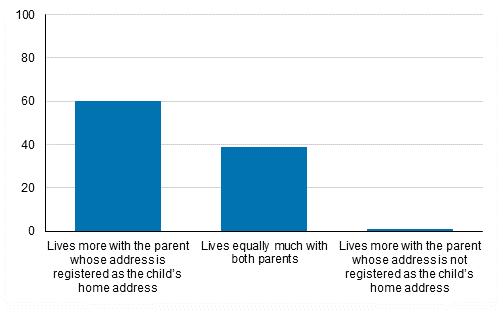Published: 17 June 2019
Around 63,000 women had children under the age of 15 living in two homes in 2018
These data derive from the results of Statistics Finland’s ad hoc module of the Labour Force Survey. The data were inquired from respondents aged between 18 and 64 that had at least one child under the age of 15. Nearly 14 per cent of the women and 17 per cent of the men who responded had children living in two homes.
Children’s shared residence was examined for the first time in Statistics Finland’s ad hoc module of the Labour Force Survey in 2018. Data on children’s shared residence has not been readily available. In the Population Information System, a child can only have one home address. For example, in cases of divorce, the child is only recorded in the family of one parent even if the child, in practice, would alternately live with both parents.
In the survey, shared residence was defined based on how the respondent answered the question “Do you have children of your own that have two homes?” If the respondent had such children, the living arrangements of each child was examined in more detail with the question: “Does your child live as much with both parents, mostly with you or mostly with the other parent?”
Even though the question about shared residence was asked from both parents, the results are processed based on the responses of one parent, namely the mother, in this publication in order to avoid possible overlapping in estimating the number of children.
Of the women aged 18 to 64 that responded to the survey and had at least one child aged under 15, nearly one in six (14%) had children that lived in two homes. Of the women that had children living in two homes, 44 per cent had one child living in two homes, 42 per cent had two children living in two homes and 14 per cent had at least three children living in two homes. There were around 110,000 children living in two homes.
Women who said their children had two homes were asked whether the parents had shared the custody of the children through joint custody with the other parent or whether one of the parents legally had sole custody of the child. Of the children that had two homes, 92 per cent had two guardians, i.e. the parents had joint custody.
The most common scenario was that the child with two homes spent a majority of the time living in the home of the parent whose address was registered as the child’s home address. Around every third child lived equally much with both parents. It was extremely rare that the child lived most of the time with the parent whose address was not registered as the child’s home address.
Of the children with two homes that lived mostly with their mother, around 40 per cent regularly also lived with their father, for example on weekends.
Children with two homes by living arrangements in 2018, %

Shared residence usually refers to a child, whose parents are no longer living together, lives alternately with both parents in two different homes. A rarer form of shared residence is that the child remains in the same home, but the parents change homes and, for example, live with the child in alternate weeks. How often the turn changes vary. The periods can be regular, for example, one week with one parent and the next with the other parent or the home can be changed more irregularly depending on the situation.
Source: Families 2018, Statistics Finland
Inquiries: Tarja Nieminen 029 551 3561, info@stat.fi
Director in charge: Jari Tarkoma
Publication in pdf-format (287.8 kB)
- Tables
-
Tables in databases
Pick the data you need into tables, view the data as graphs, or download the data for your use.
- Quality descriptions
-
- Quality Description: Labour force survey (17.6.2019)
Updated 17.6.2019
Official Statistics of Finland (OSF):
Families [e-publication].
ISSN=1798-3231. Shared residence 2018. Helsinki: Statistics Finland [referred: 26.4.2025].
Access method: http://stat.fi/til/perh/2018/03/perh_2018_03_2019-06-17_tie_001_en.html

